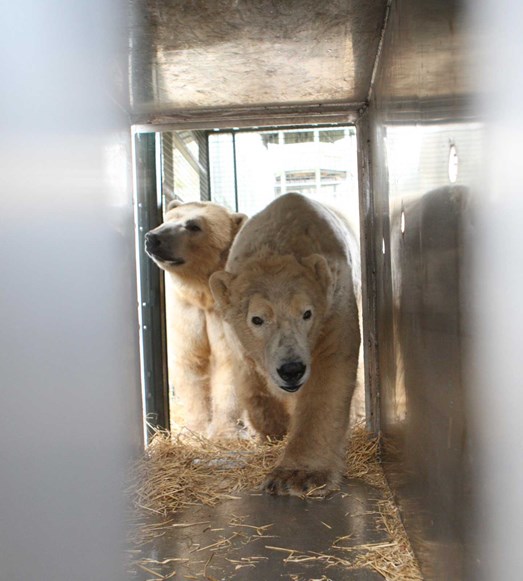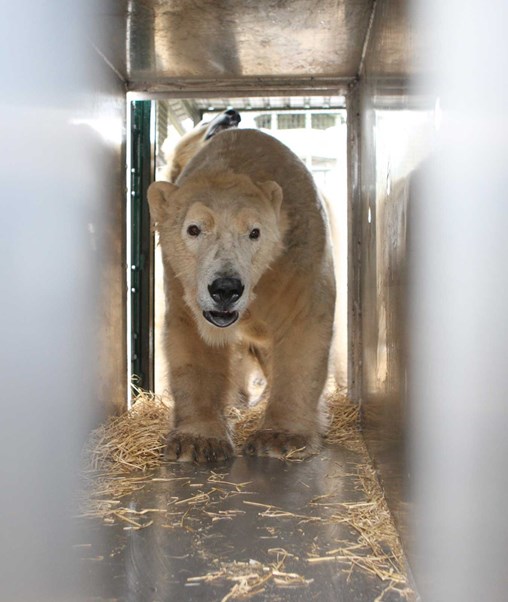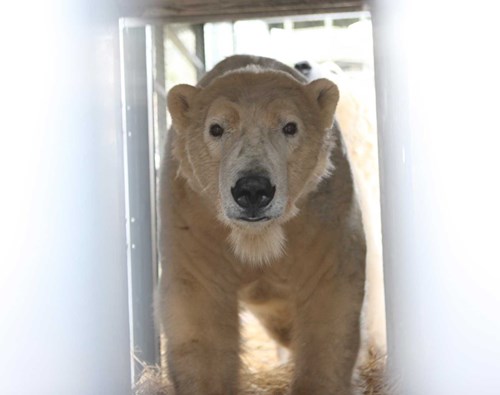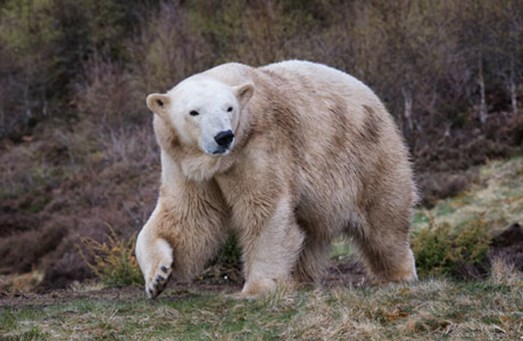Polar bear breeding begins in the Highlands
19/02/2016 in Highland Wildlife Park
The conservation charity, the Royal Zoological Society of Scotland (RZSS), announced today that preparations have begun to allow male polar bear Arktos to meet female polar bear Victoria for the first time. This is the latest and most exciting step in our efforts to support the European breeding programme for this at risk species, which is currently listed as Vulnerable on the IUCN Red List of endangered species.

Arktos (front) & Walker (back) in transportation box
Helping to protect the future of polar bears is not a straightforward task, as it is the loss of sea-ice due to climate change that is the primary threat to the species. Research shows huge uncertainty for the future of polar bears in the wild, with estimates suggesting that the global population could decline by over 30% in just three generations if sea-ice loss continues as projected*. RZSS believes that it has a duty to assist with the establishment of a healthy population of ex-situ animals, not as a substitute for conserving the species in the wild, but to ensure that there will be as broad a range of options for them in the future.
A large 3 by 1.5 by 1.8 metre transportation crate was manoeuvred into position in the male polar bear enclosure on the morning of Friday 19 February and, over the next month or so, eight year old Arktos will be habituated to it. Slowly and steadily, the process will see his keeper’s use positive reinforcement training and his favourite foods to get him used to the new addition to his enclosure. Eventually Arktos will be comfortable enough to enable his keepers at RZSS Highland Wildlife Park to transport him the one mile distance across the Park to Victoria’s enclosure.

Arktos in transportation box
Arktos is expected to travel the short distance to begin his courtship with Victoria around mid-March. A great deal of planning went into the development of Victoria’s enclosure in the Highlands and it was specifically designed with breeding in mind. The enclosure is believed to be unique as it offers maximum animal management flexibility with both a large main enclosure and a smaller holding enclosure, in which Arktos will live separate (but adjacent) to Victoria, until their behaviour indicates that signs are right for the full introduction.
RZSS has become known as one of the leading authorities on polar bears, with its enclosure design and husbandry approach being mirrored by other zoological organisations across the world. In total, RZSS Highland Wildlife Park devotes more space to polar bears than any other zoological institution in the world – over four hectares, or 10 acres, in total – and the enclosures features soft grassy areas, natural slopes, ponds and trees.

Arktos in transportation box
Modern polar bear husbandry has moved on dramatically and these enclosures are unrecognisable from those that were commonplace even up to ten years ago, where many of the negative stories about polar bears in captivity originate. Following comprehensive research by experts in North America and Europe, the zoo community now has an incredibly thorough understanding of both the husbandry requirements of the species and how to care for and improve cub survival rates.
Douglas Richardson, Head of Living Collections at RZSS Highland Wildlife Park, said: “When we first take Arktos to Victoria, he will live in a separate enclosure adjacent to hers. The two bears will be able to communicate and interact through a secure large fence to start with. We fully expect to see them showing an interest in each other right away.
“As with any introduction of large predators, the process must be approached slowly and carefully, paying close attention to positive behavioural indicators, like vocalisations and body posture. Whether we wait until Victoria comes into full breeding condition before mixing them together will depend on how they react to each other in the build-up to that key point.

Female polar bear Victoria
Richardson added: “Polar bear conservation is definitely not simple or easy, but we have an important responsibility. As a conservation body with extensive bear husbandry experience, we truly believe we cannot afford to shy away from the task in hand. If we want to keep all the conservation options on the table for the future of polar bears, we must allow for the idea that a healthy captive population may provide a solution to the species’ plight.
“The birth and rearing of polar bears cubs will be of real value to the overarching breeding programme. As well as helping to highlight the plight of polar bears in the wild, any cubs born in the foreseeable future will remain within the vital safety net of the captive breeding programme. The shrinking polar ice-cap and shortening polar ice season has pitched the species to the forefront of conservation concerns.
Richardson added: “In an ideal world, conservation would happen first and foremost in the wild, but unfortunately this is not the scenario we are dealing with. The next best thing is a combined approach, with in-situ and ex-situ work taking place simultaneously and in a joined up manner. The zoo community has a duty of care to help this species survive and collectively our work is helping to preserve as varied a mix of genes as possible; it will also maintain the option of being able to return animals to the wild at some point in the future. Whilst Victoria’s cubs will never go back into the wild themselves, further down the line her offspring may well play a key role in restoring or augmenting populations in the Arctic.”
…ends…
Strictly embargoed until 1pm on Friday 19 February 2016
A link to images of Victoria and Arktos can be found at the following link: https://www.dropbox.com/sh/uxff3orbsugje63/AACh3kjymOlZtK8fjgMoE4eKa?dl=0
These are free to use, please credit RZSS.
About the polar bears and the Royal Zoological Society of Scotland:
- Victoria arrived at RZSS Highland Wildlife Park from Aalborg Zoo in Denmark in March 2015. An 18 year old female polar bear, she was born on 12 December 1996 at Rostock Zoo in Germany. Victoria weighs around the 250kg mark, which is about right for a non-pregnant female at this time of year. If she falls pregnant, her keeper’s will help her weight to reach over 300kg as this is the crucial minimum weight that females need to reach to successfully rear cubs.
- Victoria gave birth in 2008. Milak, her first cub, became an online sensation when hundreds of thousands of people from 75 countries around the world followed the early days of the cub’s life whilst still in the maternity den. It was one of the first times that webcams were able to show what life is like with a mother and a new-born cub. In December 2014, at natural dispersal age, Milak was transported to Zoo Saint-Félicien in Quebec as part of an exchange to augment the Canadian captive polar bear programme. Funnily enough there was confusion over Milak’s sex; at first the cub was understood to be male, but then was later revealed to be a female.
- Our two males, Walker and Arktos, are seven and eight respectively. Walker was born in Rhenen Zoo in the Netherlands on 7 December 2008 and came to live at RZSS Highland Wildlife Park in November 2010. Arktos is only a year older and was born on the 30 November 2007 at Vienna Zoo, before he moved to Hannover Zoo in 2010. Arktos arrived at the Park on 4 April 2012.
- Arktos and Walker have been firm friends ever since they met in April 2012 and like to spend their time chasing, wrestling, swimming and eating together. They are both very playful. The two bears are trained by keepers to allow simple health and weight checks without the need for anaesthesia. Arktos and Walker are the only two male polar bears on public display in Scotland and share a custom built enclosure that is considered one of the world’s largest and best polar bear enclosures at almost six acres in size. The extensive and varied natural landscape provides enrichment for the bears.
- RZSS’ first polar bear was a male called Snowball who arrived at RZSS Edinburgh Zoo just before it opened to the public in July 1913. Possibly the most famous and the last of the Zoo’s bears was Mercedes, who lived at RZSS Edinburgh Zoo for some years before moving to RZSS Highland Wildlife Park. She was born in the wild in the western Hudson Bay region of Manitoba, Canada in late 1980 or 1981. She began wandering into the town of Churchill and as a result was going to be shot, but luckily a concerned member of RZSS intervened and managed to save Mercedes from certain death and arranged for her to be brought to RZSS Edinburgh Zoo in 1984. Whilst at the Zoo she reared two cubs, which were sired by her partner Barney (who was born at Whipsnade Zoo and died at Edinburgh Zoo in November 1996). Mercedes was then moved to RZSS Highland Wildlife Park on 19 October 2009 to a much larger enclosure which was specially designed for her. The European breeding programme coordinator for polar bears soon got in touch after seeing the size and natural complexity of the facility and asked if we could take Walker, then aged two. Walker and Mercedes shared an enclosure for a year before Mercedes’ age related health problems necessitated her being humanly euthanised.
- Victoria has her very own large custom-built enclosure, which features a pond and soft areas of ground, as well as plenty of space for her to explore. In total, Highland Wildlife Park devotes more space to polar bears (over four hectares, or 10 acres, in total) than any other zoological institution in the world, and the successful work of the Park in enclosure design and development is being mirrored elsewhere.
- Victoria’s enclosure is completely separate to male polar bears Walker and Arktos, who have a large bachelor enclosure at the other side of the Park; this allows us to mimic the behaviour of polar bears in the wild who only come together to mate.
- Victoria is the only female polar bear in the UK. Walker and Arktos are the only male polar bears in Scotland.
- Arktos has been chosen to breed with Victoria as he is older and a genetically more important male. Walker’s genes are already well represented within the captive population.
- Polar bears are currently classified as Vulnerable on the IUCN Red List as they rely almost entirely on sea ice as a seal hunting platform for survival and this environment is being dramatically reduced due to climate change. As a result of declining polar bear numbers, Highland Wildlife Park intends to breed and rear polar bear cubs, which will help bolster the European breeding programme.
*Obbard et al. 2010, Stirling and Derocher 2012, USFWS 2015
For further information please contact:
Gavrielle Kirk-Cohen, PR Coordinator for the Royal Zoological Society of Scotland, on 0131 314 0383 or gkirkcohen@rzss.org.uk
Rachel Goddard, PR Manager for the Royal Zoological Society of Scotland, on 0131 314 0312 or rgoddard@rzss.org.uk
Featured Content
Featured Articles

An update from the Budongo Forest
19/04/2024 in Conservation

Edinburgh Zoo named best zoo in Scotland
15/04/2024 in Edinburgh Zoo

























Follow EZ